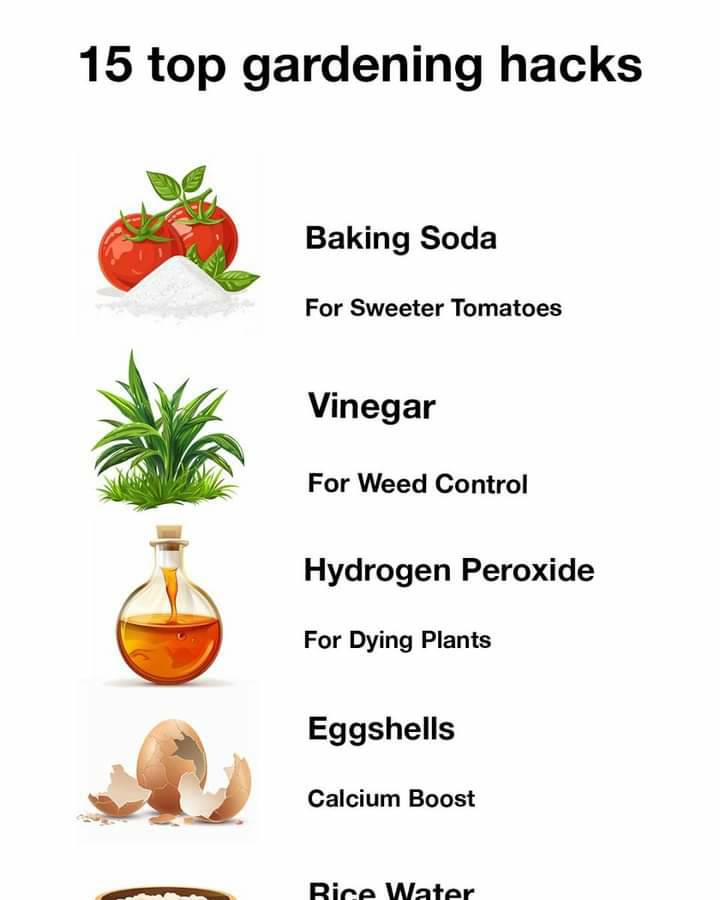Gardening is a rewarding hobby, but it can come with its challenges. Whether you’re a seasoned gardener or just starting, these 15 top gardening hacks will help you tackle common problems, boost plant health, and make your garden thrive. From natural pest control to enhancing soil quality, these tips are designed to make your gardening efforts more effective and eco-friendly.
1. Eggshells for Soil Enrichment
Recipe: Crush eggshells into small pieces and mix them into your soil.
Why It Works: Eggshells are rich in calcium, which helps prevent blossom end rot in tomatoes and peppers. They also improve soil structure and deter pests like slugs and snails.
2. Banana Peels for Potassium
Recipe: Bury banana peels in the soil near your plants or blend them into a compost mix.
Why It Works: Banana peels are a great source of potassium, which supports plant growth, flowering, and fruiting. Potassium helps plants develop strong roots and improves resistance to diseases.
3. Tea Bags as Fertilizer
Recipe: After brewing your tea, bury the used tea bags in the soil or add them to your compost.
Why It Works: Tea bags add nutrients like nitrogen and potassium to the soil. They also help improve soil structure and promote healthy plant growth.
4. Aquaponics Water for Nutrients
Recipe: Use the water from your fish tank or aquarium to water your plants.
Why It Works: This water is rich in nutrients from fish waste, which acts as a natural fertilizer. It provides essential nutrients like nitrogen, phosphorus, and potassium to your plants.
5. Coffee Grounds for Acid-Loving Plants
Recipe: Collect used coffee grounds and mix them into the soil or use them as mulch around acid-loving plants like blueberries, roses, and azaleas.
Why It Works: Coffee grounds are slightly acidic and rich in nitrogen, which can help improve soil structure and provide essential nutrients to acid-loving plants.
6. Epsom Salt for Greener Leaves
Recipe: Dissolve 1 tablespoon of Epsom salt in a gallon of water and use this solution to water your plants once a month.
Why It Works: Epsom salt provides magnesium, which is crucial for photosynthesis and helps plants take in other essential nutrients, leading to greener, healthier foliage.
7. Cinnamon for Fungal Prevention
Recipe: Sprinkle cinnamon powder on soil and around seedlings.
Why It Works: Cinnamon has natural antifungal properties that can help prevent damping-off disease and other fungal infections in young plants.
8. Milk for Powdery Mildew
Recipe: Mix one part milk with two parts water and spray the solution on affected plants.
Why It Works: Milk has natural antifungal properties and can act as a preventive and treatment for powdery mildew, a common plant disease.
9. Aspirin for Plant Immunity
Recipe: Dissolve one aspirin tablet in a gallon of water and use it to water your plants every three weeks.
Why It Works: Aspirin contains salicylic acid, which can boost the plant’s immune system, helping it resist diseases and pests.
10. Vinegar for Weed Control
Recipe: Spray pure white vinegar directly on weeds, taking care to avoid desirable plants.
Why It Works: Vinegar is highly acidic and can kill weeds by drying them out. It’s an effective and eco-friendly alternative to chemical herbicides.
11. Honey for Rooting Cuttings
Recipe: Dip the cut end of a plant cutting into honey before planting it in soil.
Why It Works: Honey has natural antibacterial and antifungal properties that help prevent rot and encourage healthy root growth in plant cuttings.
12. Baking Soda for Fungal Control
Recipe: Mix 1 tablespoon of baking soda with 1 gallon of water and spray on plants to prevent fungal infections.
Why It Works: Baking soda helps neutralize fungal spores and can prevent the spread of diseases like powdery mildew.
13. Mulch for Moisture Retention
Recipe: Apply a layer of organic mulch, such as straw, leaves, or wood chips, around your plants.
Why It Works: Mulch helps retain soil moisture, reduce weed growth, and regulate soil temperature, creating a more stable environment for plant roots.
14. Garlic for Pest Control
Recipe: Blend garlic cloves with water and a bit of soap, then strain and spray the mixture on plants.
Why It Works: Garlic has natural insect-repelling properties and can help deter pests like aphids, beetles, and mites.
15. Companion Planting for Natural Pest Control
Recipe: Plant certain herbs and flowers alongside your vegetables to naturally repel pests.
Why It Works: Companion planting uses the natural properties of plants like marigolds, basil, and nasturtiums to keep pests away and improve plant health. For example, marigolds can deter nematodes, and basil can repel mosquitoes and flies.
By incorporating these top gardening hacks into your routine, you’ll not only enhance the health and productivity of your garden but also reduce the need for synthetic chemicals and expensive solutions. Happy gardening! 🌱

Good information, I want to know how to measure and control soil pH using homemade remedies